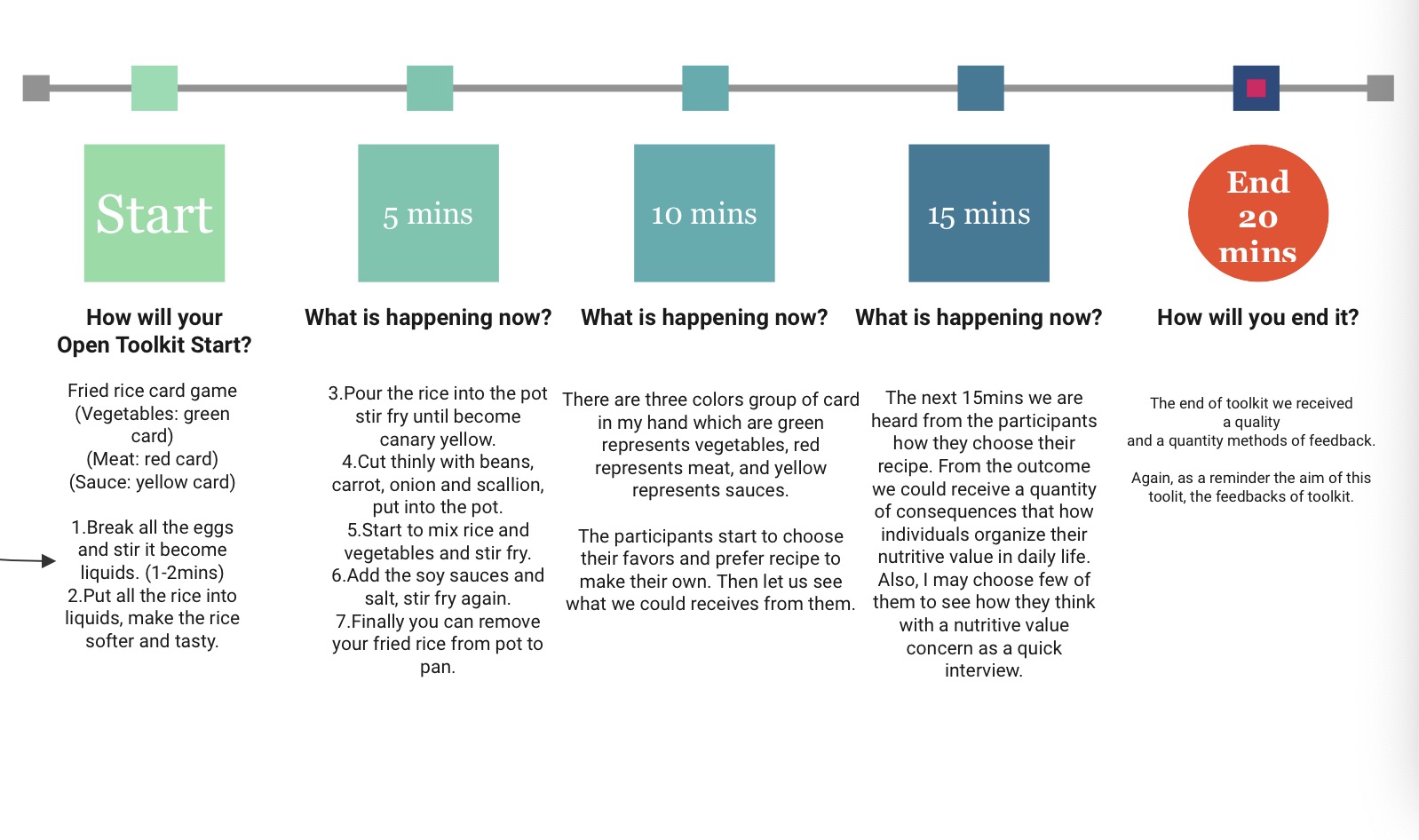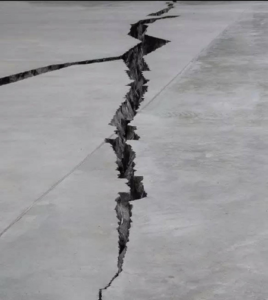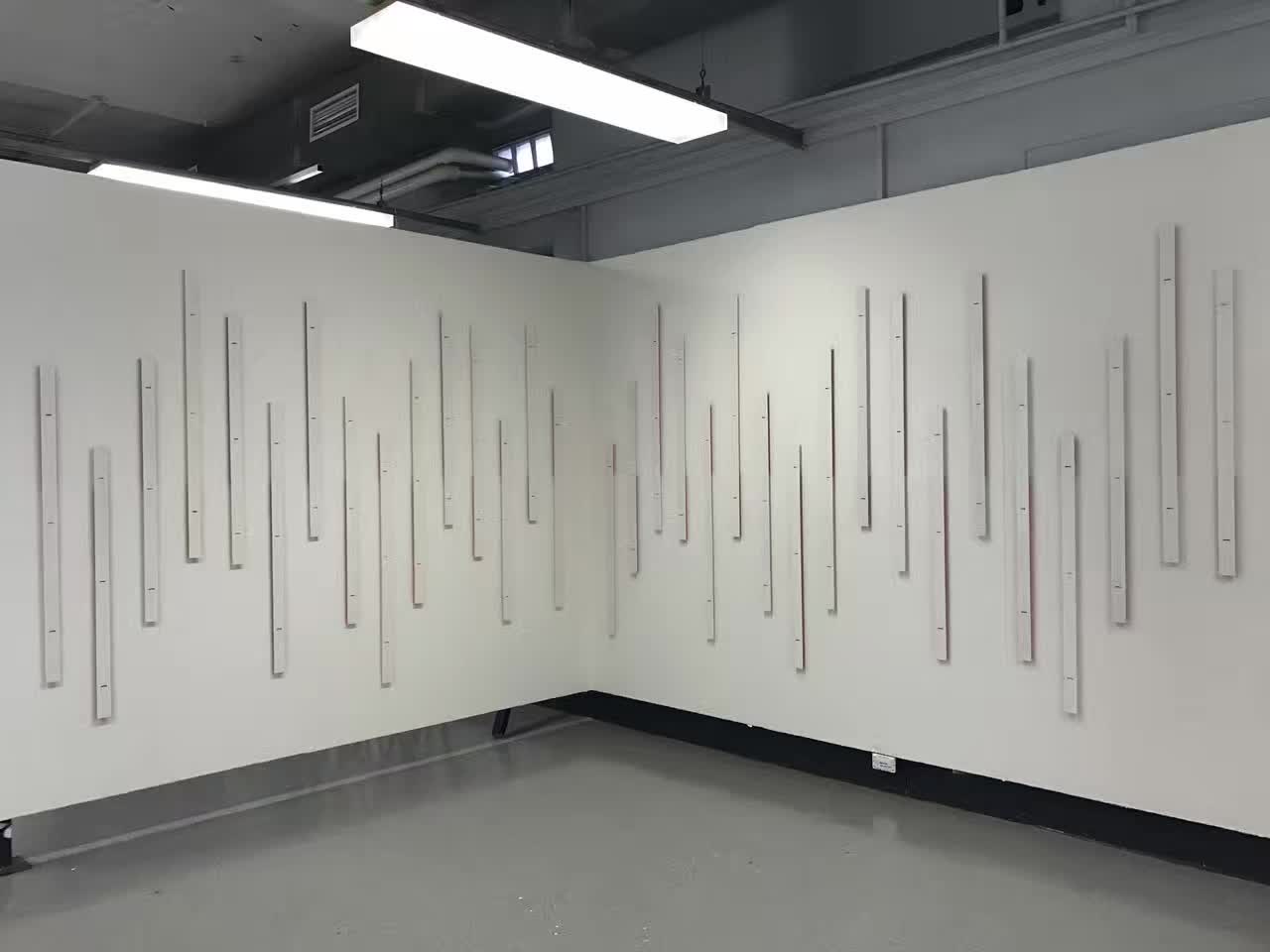My comments:

My comments:
‘Unconference’ that combines presentations with responsive discussion. One of the most obvious feature of a unconference is which there is no author or the authored; everyone is a participant. These include the material and conceptual organising creative ideas and cultural production linked to four elements: participation and collaboration, process and outcome. What we need to documented in these two weeks as a ‘barcamp’ which explored “dialogic art through a dialogue that moves amongst their respective points of view, the epistemological foundation of this ‘barcamp’ can be defined as dialogic because it understands knowledge as arising from social relations and enacted through intersubjective exchange. ” (Bradfield, 2013)
Barcamp as concerned as heterogeneous becoming achieved through dialogic exchange. A fruitful collaboration combined with different subject matter related to cooking, weaving, drawing, photographing and communicating and sharing stories. Bringing together different toolkits into a common idea is that our basho has been discussing over the past two weeks. Finally, our basho takes the way of perceiving the world as the concept integrated with our basho.

We ran everyone’s toolkit as a basho this Thursday. Everyone’s toolkit was interesting, the steps were clear, and the instructions were followed step by step. When running each toolkit, everyone would share their feelings or ideas with each other, and communication was very easy in an open communication environment located in classroom in Hunter building.
I turned my toolkit into a kind of card game, where each participant could choose their favorite flavor, different vegetable or meat food, and then after writing it, each participant would evaluate their own recipes among themselves, and then they would receive the recipes of others and ask them to comment on whether the recipes were nutritionally balanced or not, and if they are not do they have any suggestions.
I was deeply impressed by the story sharing toolkit and photo taking toolkit. I shared a story from my childhood, which reminded me of some good memories with my friends. Whether it is music, photos or stories, they all record the different ways of perceiving the world and the joys and sorrows of humanity.
Each toolkit is for each participant to complete their own work. If all participants can interact to complete artwork collaborate together, the interaction of the cultural environment and individual initiative will be enhanced.
To summarize, freedom zone is significant contributed into contemporary art practice, similarly, what we are learned in themes of ‘play’ or themes of ‘common’ related to ‘rules of score’ and ‘culture cluster’. Moreover, from traditional art to contemporary art, the transformation of art forms reflects the aggregation of a culture, the diversity of a nation, and the development of future art.
Reflection on how to improve the toolkit interaction on 1st December. Consider eliminating some conversations and comments and adding a fun physical interaction session within 20 minutes. In addition to having participants make their own recipe, the next session involves interacting with other people in different color groups to make a new recipe when they get a color group card.
References:
Bradfield, Marsha (2013) Utterance and Authorship in Dialogic Art: or An Account of a Barcamp in Response to the Question, ‘What is Dialogic Art?’. PhD thesis, University of the Arts London.

How we understand what is practice, practice theories embrace aspects such as knowledge, meaning, human activity, science power, language, social institutions and human transformation. Moreover, the book “Practice Theory and Education: Diversity and Contestation” claims that ‘practices are formed by being in and participating in the social world. Understanding thereby practices requires a theory, or suite of theories, that illuminate the socialness and sociality of practical being, action and interaction. (Grootenboer&Choy, 2017) Practice contains order schedule of action, an interaction of coding and decoding.
In a ‘practice turn’, students could experience themselves in teaching roles and make experiences on the question of an educational practice being an art practice. It is important to consider six elements include goals, materials, codes, timing, feedbacks and documentation. Space and the presence at the site is also very significant for all participants which meeting grounds for learning, teaching, discussing, addressing difficulties, solving problems.
As concern as SECI mode what we are learned in the class, normally we are learning a process contains tacit knowledge, and how we fully describe how to achieve that goal is to externalize the tacit knowledges. To combine it become your own practice of internalization. In the book ‘you must change your life’, it claims a concept of ‘anthropological proportion'(Sloterdijk,2013) We have some common types of anthropological research methods include (1) immersion in a culture, (2) analysis of how people interact with their environment, (3) linguistic analysis, (4) archaeological analysis, and (5) analysis of human biology. (Bernard,2017) Due to ‘practice turn’, we are focusing on analysis how people interact with their environment.


My decode of recipe is how to complete a fried rice dish. In our daily life, we have many practice sessions, such as how to drive a car, how to cook a meal, compare to learn a language or drawing, cook meal is useful and functional knowledge that based on our taste sense. We should think about what we should eat, how many nutrition that human body need. Therefore, to solve a basic everyday life problem fundamentally. That is my aim of my practice, how many people get the knowledge that the proportion of nutrition their body need, to aware and to practice as simple as possible.
The steps of knowledge externalization should be as simple as possible to make it easy for more people to understand. I have made it clear what materials and how many minutes are needed for each step. If more people can be involved, how to make them more interesting is what I need to think about next. For example, instead of just talking to each other, add more body language, or make it a game session to get the audience involved.
We are focused how people interact with their environment, Environmental anthropology within the field of anthropology that takes an active role in examining the relationships between humans and their environment across space and time. How we shape the environments we live in and how relations with the environment shape culture.
My next task is how to change this externalized step practice into a cultural environment where everyone can participate and interact. Continuous practice is a boring process to achieve the final goal. I need to prepare for this process by adding some questions or body language interaction that can make participants interact with each other.
References:
Bernard, H. R. (2017). Research methods in anthropology: Qualitative and quantitative approaches. Rowman & Littlefield.
Grootenboer, Edwards-Groves, C., & Choy, S. (2017). Practice Theory Perspectives on Pedagogy and Education: Praxis, Diversity and Contestation. Springer Singapore Pte. Limited.
Sloterdijk, P. (2013). You must change your life. Polity Press.
Art is becoming a zone of freedom to present, ungraspably complex and diverse. The variety of contemporary forms, techniques, and subject-matter in art is indeed bewildering. Nowadays, opening educational resources is giving knowledge for free, reveals the potential implications which approach to an altruistic motivation. The adaptions and remixes can function as forms of feedback, the more people share, remix and repurpose, the more useful materials could become. How knowledge is constructed through forms of social interaction, we are learned by doing during this process.
Experience:
The workshop contains buttons made of wood, devices made of iron buckets and flags, houses made of wood, and the garden made of mud. The collection of tools that used to ‘do’ works of art reflects interdisciplinary of realm, using tools to express concepts is the main technique of contemporary art. It can be any material even sketches. To give my point of view, the instructions expressed a scenario of alien war, our group came up with the idea of using buttons one to three to create a series of instructions, such as the Morse code during the period of war. There are also flags of different colors representing armies, thus giving a background of war. Later made of wood homes, and clay giants, and a child made of wood bows and arrows as weapons and other tools are used to pave the way for a scenario of ‘war’. (Figure 1,2,3)
Reflection:
The shift was prepared for by postmodern critique which in a complex series of theoretical moves, and art world has taken up the politically liberal aspect of this rhetoric.



Furthermore, the Colombian artists Doris Salcedo, she worked on sculptures and installations who open up a deep and poignant space for mourning, focusing on the human suffering caused by war and violence over the past thirty years as a political and spiritual reflection. War has brought pain and war has brought inspiring works of art, thus if one day there is no conflict in the world, is there less art engagement to insist or alive?


Action:
Based on Experience and Reflection, how to engage in artworks by using toolkit. To give my point of view, it is vital that a moving motive from interaction to influence, correlates big thinking such as geography, physics, politics, environment. Art is an expressive and visual discipline therefore an ideal way to bring for example physics to live, physics is about understanding the behaviour of the world around us, it has a string link to global problems and has a huge impact on a wide range of society. I went to the exhibition of physical artwork last week, it brings more influence that to get familiar with our physical world. The below image shown the Bijels, acronym for bicontinuous interfacially Jammed emulsion, three dimension materials consisting of two intertwining liquid stabilized by a layer of micron-sized particles at their interface. Also, to attend the lecture next week as Hathaway shows, the world-making capacities of mushroom radically challenge is orthodoxy by revealing the lively dynamism of all forms of like. From a geographical perspective, to see today’s mushroom renaissance in compelling new directions.

References:
https://www.ph.ed.ac.uk/events/2022/82725-fusion-physics-x-art
The art assignment of whitescapes( https://www.theartassignment.com/assignments/whitescapes) (Figure 1) contains a comprehensive understanding of color due to a diversity of personal experience. Basically, when we talk about one color which produce a multifarious selections in individual’s mind. This masterpiece is formed by colors particles and made with panels and canvas. The visual impact on colors formed how those shape of color construct as an integral area to look at. The artist starts with two contrasting colors to give the audience a visual comparison image. That what we can say one hundred person could see 100 different white or other colors in their mind, there is not typical color to say but feel in a totally subjectively though the visual system of humanity.
 (Figure 1)
(Figure 1)  (Figure 2)
(Figure 2)
I have done a similar conception of art piece when I am still an undergraduate student, the shown image above is an area of wall, we are a group of three, we considered ‘white’ as an original color, white produce everything, also white could see anything. There are a range a diversity of ‘white’ how individuals could recognized. For example: ivory white, oyster white, pear white, jade white, silver white and flake white. There are two different white prepared in this piece related to the color of wall and color of panel. Furthermore, we are not considered with a LED light or flashlight when we wrote our proposals. To sum up the core idea of this art piece which is “white not just white, but is everything.” The result of white wall convey a simple idea with a satisfied outcome. We could see a spectrum of colors such as yellow or green or pink or blue reflected on the wall in our visual system.
From a constructivist perspective, I will consider my art assignment as a experimental art, we are learned by doing and to think about what is color and how we produce color by keep doing practical works. There is not a specific theory to think about, but a kind of artistic attempt and experience art practices. Adam provided the practice is the moderation of form of behaviour judged to be associated with learning (Easen&Bolden, 2005) P,2006), also the mental activities and processes are indirectly observed through the prism of actions and reactions, which in turn are seen to provide reliable information. (P, 2006)
To sum up, I think the theory of constructivism has something in common with theory of Hume, his theory of empiricism which attributes to experience the origin and the source of validity of all possible knowledge. (G, 1991) Hume thinks that everything we are is based on experience, our mind is like a blank panel, everything in the mind is a perceptual experience obtained from observation of things, or impression or feelings. Hume’s empirical approach is based on perception first and then observation. To sum up, the perceive system from our cortex of brain, to see color different respectively which maintain with Hume’s theory from my point of view.
References:
Adams, P. (2006). Exploring social constructivism: Theories and practicalities. Education, 34(3), 243-257.
Deleuze, G. (1991). Empiricism and subjectivity: An essay on Hume’s theory of human nature. Columbia University Press.
Due to an ‘educational turn’, the academy wanted to “stimulate reflections on this potentiality within society”, which we are transfer to an academy learning to practice learning, in this para-acadamic background of art education, include and “extend the possibilities for experiential leaning or action research”. (Neil, 2019) Thus, we are work with a group of basho contains five principles of learning, which are everyone is equal but different, we are sharing our contexts together and may reset up meta-knowledges during the basho work, also we are work respective and practical and learn from other people concerned as a method of nonlinear learning.
The green basho meeting is held in last Thursday, during the communication with multiple peers, it is difficult for everyone to express their own ideas that be received and accepted. Sometimes, I would like to express but it is difficult to do so. Also,I want to openly collaborate with my peers so that we can learn together.
In Thursday’s meeting, our members produced different perspective of view, the comparison of consensus point everyone to use short time to write on the whiteboard, a little discussion on personal point of view. In general, some people interact more with each other than others. Maybe we are not familiar with each other in the first time, every individuals has a different personality, a team in the conference, if overexpressing their views is not necessarily, but at the same time not to express is a kind of negative way, however if we all express our opinion that might discuss without a consequence, based on that it is also a difficulty for basho discussion.
As our counselor reflected some feedbacks on Tuesday, he said that in the future we can constantly to improve some disadvantages every week with our basho meeting, to increase the interaction between inter-subject activities, make each team member can feel the fun of our workshop, they make sure can learn something from others, each individual’s point of view is also vital significant that how we could find a balance point on it, It also allows each of us to find their position and value in the workshop discussion.


The positive note I putted on the miro whiteboard is that we can encourage everyone to express their opinions, listen to others carefully and learn to adopt others’ opinions, to find a balance between each other. Furthermore, every single individual interact with other is important, which helps everyone to enjoy the workshop. On the negative note I wrote about two things which is no interaction and bad attitude. From the perspective of attitude, which is related to ethics, friendly people for our whole team advance is necessary, if a person to treat others in a unfriendly way, for the whole team’s environment and people around you is not good, thus I think this is important, and friendly treat people play a significant role. To sum up, Ideal notes are closer to positive notes and prohibited notes are closer to negative notes. The reality is probably a little bit more in the middle, a lot of times you don’t meet people who have a very bad attitude and you don’t meet people who are very positive, so maybe the group members need to communicate with each other and find a balance between each other and the group.
Finally, I would like to talk about the meeting place. All the above are ethical principles. It is easy to find and change the meeting place, which will also help improve the work efficiency of the group and make people feel fresh, so as to enhance their interest in the seminar. For example, we can meet in a Cafe next week and have a cup of coffee and some sandwiches together. Constantly inspired by the experience of life and the desire to communicate with others. From the physical environment and spiritual perspective to improve quality and efficiency with our basho.
References:
Mulholland. (2019). Re-imagining the Art School Paragogy and Artistic Learning / by Neil Mulholland. (1st ed. 2019.). Springer International Publishing. https://doi. org/10.1007/978-3-030-20629-1

This is your first post. You can edit this or delete it and start blogging.
You should read the Terms of Use if you haven’t already.
For help and advice on getting started with a WordPress blog, see the Academic Blogging help pages.
Your blog is private by default
You can open your blog up to as many or as few people as you like in Dashboard > Settings > Reading > Site Visibility:
The featured image on this post comes from the University Collections. If you want to use more images in your blog posts, or perhaps use your own choice of image in your blog header, you can:
Powered by WordPress & Theme by Anders Norén